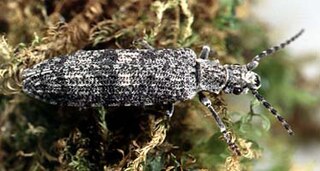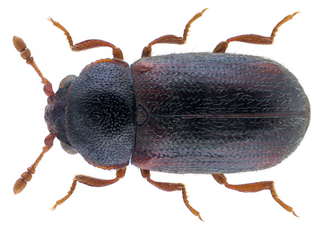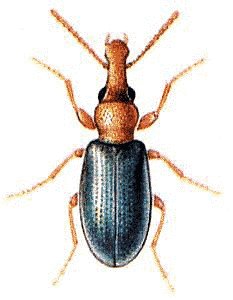
Polyphaga is the largest and most diverse suborder of beetles. It comprises 144 families in 16 superfamilies, and displays an enormous variety of specialization and adaptation, with over 350,000 described species, or approximately 90% of the beetle species so far discovered.

Myxophaga is the second-smallest suborder of the Coleoptera after Archostemata, consisting of roughly 65 species of small to minute beetles in four families. The members of this suborder are aquatic and semiaquatic, and feed on algae.

Cucujoidea is a superfamily of beetles. This group formerly included all of the families now included in the superfamily Coccinelloidea. They include some fungus beetles and a diversity of lineages of "bark beetles" unrelated to the "true" bark beetles (Scolytinae), which are weevils.

The Lymexylidae, also known as ship-timber beetles, are a family of wood-boring beetles. Lymexylidae belong to the suborder Polyphaga and are the sole member of the superfamily Lymexyloidea.

Vadim Gennadyevich Gratshev was one of world leading experts in palaeoentomology. Vadim graduated from the Moscow State Pedagogical Institute in 1987 and taught biology at a high school for three years until 1989. Then he decided to pursue academic science and joined the Laboratory of Arthropods at the Paleontological Institute of Russian Academy of Sciences in 1991, first as a Kuperwood Fellow of the Academy of Natural Sciences, and since 1994 as a full-time researcher. Weevils and dryopoids were always his main passion, although his area of interests extended far beyond that. He produced over 20 scientific papers, including an outstanding comparative study of the hindwing venation of the superfamily Curculionoidea published in co-authorship with Vladimir Zherikhin. Being a keen field researcher, he participated in numerous expeditions to the Maritime Province and Sakhalin Island, Kuznetskii Alatau, Novosibirsk Region, Armenia, Azerbaijan, Georgia, Tajikistan, Turkmenia, and Ukraine. The material he collected on his trip to the Drakensberg and Zululand in 2005 inspired him to commence a new project on Afrotropical Elmidae and Anthribidae. Being an optimistic, cheerful multi-talented individual with subtle sense of humour, he did not restrict his interests to extinct and extant beetles. He was an expert in noble orchids, aquarium design and raising geckos, and published several papers on those topics. He was a skillful wood-carver, and his knowledge of Japanese history and literature was not amateur.

Cupes is a genus of beetles in the family Cupedidae. The Cupedidae are typical “reticulate” or “net-winged” beetles with incompletely sclerotized elytra that produce the characteristic reticulate appearance.

Priacma is a genus of beetles in the family Cupedidae. It contains a single extant species, Priacma serrata native to western North America and one fossil species, P. megapuncta from the Cenomanian aged Burmese amber. Species previously assigned to the genus from the Yixian Formation of China have been subsequently placed in the separate genus Apriacma.

The Ommatidae are a family of beetles in the suborder Archostemata. The Ommatidae are considered the extant beetle family that has most ancestral characteristics. There are only seven extant species, confined to Australia and South America. However, the geographical distribution was much wider during the Mesozoic spanning across Eurasia and Australia, suggesting that they were widespread on Pangea. So far, 28 extinct genera containing over 100 species of these beetles have been described. Three extant genera have been assigned to this family: Omma,Tetraphalerus and Beutelius. The family is considered to be a subfamily of Cupedidae by some authors, but have been found to be more closely related to Micromalthidae in molecular phylogenies. A close relationship with Micromalthidae is supported by several morphological characters, including those of the mandibles and male genitalia. Due to their rarity, their ecology is obscure, it is likely that their larvae feed on deadwood.

Kateretidae is a family of short-winged flower beetles in the suborder Polyphaga. There are 10 extant and 4 extinct genera, and at least 40 described species. They are found worldwide except in New Zealand. Adults are anthophagous, feeding on flowers, while the larvae are spermatophagous inside the flower corolla.

Sphindidae is a family of beetles, in the suborder Polyphaga. They are also known as slime mold beetles due to their exclusive feeding on slime molds during adult and larval stages, other aspects of their life history are obscure. Palaeontological discoveries since 2015 have added to the geologic history of Sphindidae, including the discovery of Libanopsis, placed in the extinct subfamily Libanopsinae.

Helotidae is a family of beetles, in the suborder Polyphaga. The family includes about five extant genera, Helota MacLeay, Neohelota Ohta, Afrohelotina Kirejtshuk, Metahelotella Kirejtshuk, and Strophohelota Kirejtshuk. Helotidae are found mainly in the Old World tropics and are absent from Australia and Madagascar. The antennae are clubbed on the final three segments and is retractable within grooves under the head. The wings have reduced venation with just 4 anal veins.

Phloeostichidae is a family of beetles in the superfamily Cucujoidea. There are at least three genera in Phloeostichidae.

Salpingidae or narrow-waisted bark beetles is a family of beetles, in the large suborder Polyphaga. The species are small, about 1.5 – 7 mm in length. This family is worldwide distributed and consists of about 45 genera and 300 species.
Decliniidae is a family of beetles in the large suborder Polyphaga. It contains the single genus Declinia with two species, Declinia relicta and D. versicolor, found in far eastern Russia and Japan.

Monotomidae is a family of beetles in the suborder Polyphaga, containing the following genera:

Callirhipidae is a family of cedar beetles in the order Coleoptera.

Elmidae, commonly known as riffle beetles, is a family of beetles in the superfamily Byrrhoidea described by John Curtis in 1830. Both adults and larvae are usually aquatic, living under rocks in fast-flowing shallow areas of streams, such as riffles, feeding on algae and biofilms. There are more than 150 genera and 1,500 described species in Elmidae. The oldest record of the group is Cretohypsilara from the Cenomanian aged Burmese amber.

The Protocoleoptera are a paraphyletic group of extinct beetles, containing the earliest and most primitive lineages of beetles. They represented the dominant group of beetles during the Permian, but were largely replaced by modern beetle groups during the following Triassic. Protocoleopterans typically possess prognathous (horizontal) heads, distinctive elytra with regular window punctures, culticles with tubercles or scales, as well as a primitive pattern of ventral sclerites, similar to the modern archostematan families Ommatidae and Cupedidae. They are thought to have been xylophagous and wood boring.

Throscidae is a family of small false click beetles in the order Coleoptera. In North America, there are 3 genera and 20 described species.


















